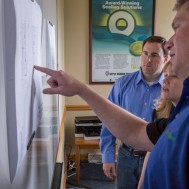When customers work with Apple Rubber, our on-staff design engineers answer technical questions, address any adjustments needed, and fully customize both the experience and the solution. The mission is not simply selling — it’s creating, supporting, and integrating.
The Apple Blog recently spoke with Apple Rubber Project Engineer Kevin Oberholzer about the company’s in-house design engineering capabilities.
Apple Blog: What is the advantage to having design engineers on staff?
Kevin Oberholzer: Seals are our primary focus, so our engineers have the capabilities and experience in that field. There are situations where a customer designs a custom seal for their unique application on their own. Many times these designs cannot be realized due to material or geometries that are not manufacturable. Our engineering group has already addressed and solved many issues, whether through materials, a specific elastomeric compound, or geometry design.
AB: So are you fixing it, or building a new one?
KO: About half of our inquiries—whether through trade shows, our web site, or a phone call—are customers who have a problem, i.e. an existing seal or application that doesn’t work. The other half are new designs or applications, where none of the components have been made yet.
To get started, one of our engineers—either on location or at our headquarters—looks at the application and addresses design issues or solves the problems. We then look at creating a prototype or providing parts to be able to prove the design.
The types of problems that could arise with the new or adjusted part include issues with component assembly or performance. We adjust if need be, then we look at making production and supplying the part.
AB: Talk about Apple Rubber’s in-house testing.
KO: Our QC department reviews the requirements—the drawing specified materials, surface finish, geometry tolerances, and any other attributes of the seal important to the application. Before we ship any product—whether prototype or production—it is tested and verified.
AB: You mentioned location engineers?
KO: Apple Rubber looks at the value-add of having engineers outside of the main corporate office. Sometimes, the best option is to have an engineer sit down with a customer and look at the existing application or walk through the design process for a new application.
This is helpful especially if it is an existing application. The visit becomes a problem-solving adventure. The problem may not be evident, or may not be communicable any other way — it’s a great advantage to look at the function. A seal could be leaking because of a tiny contaminant.
AB: So what’s the benefit of having a design engineer at trade shows?
KO: We try to have representatives from engineering and sales at every show. There are advantages for the customers, and for us, too. The salesperson may have a relationship with the person making the inquiry, and, if the salesperson gets a technical question, I can join the dialogue. There is a comfort level created. The sooner we help our customer feel that they are valued and are getting value, then we have a sale.
AB: How do you work with the designs?
KO: Solidworks is the leading CAD 3D software in the industry. Customers can simply send us their three-dimensional models and we can view, interrogate, and see how the assembly is working. We can recommend improvements to the performance or the design.
It also removes any guesswork. There is very little operator involvement. It’s all right there: the radius, where the sharp edges are, the dimensions. The seal component is created from the 3D model. That same model is then used to make a mold drawing, and is downloaded into the machining center to actually cut the mold.
AB: There’s some company pride coming through!
KO: Apple Rubber probably has the largest inventory of non-standard O-ring sizes available. If a customer is looking for, say, a microminiature, we will usually have something close—especially if someone has problems with an existing application, we are able to respond very quickly. It gives us and our customers an advantage.`
